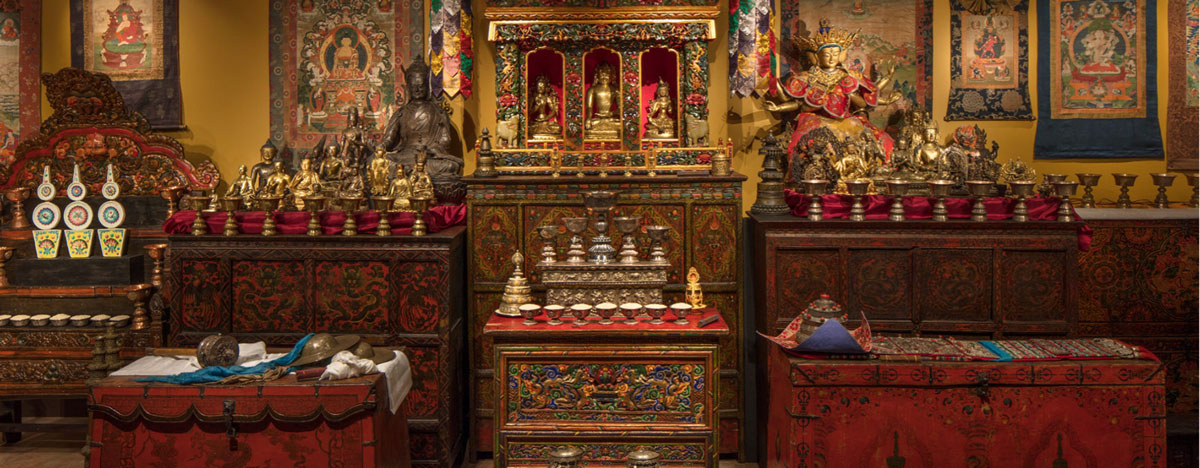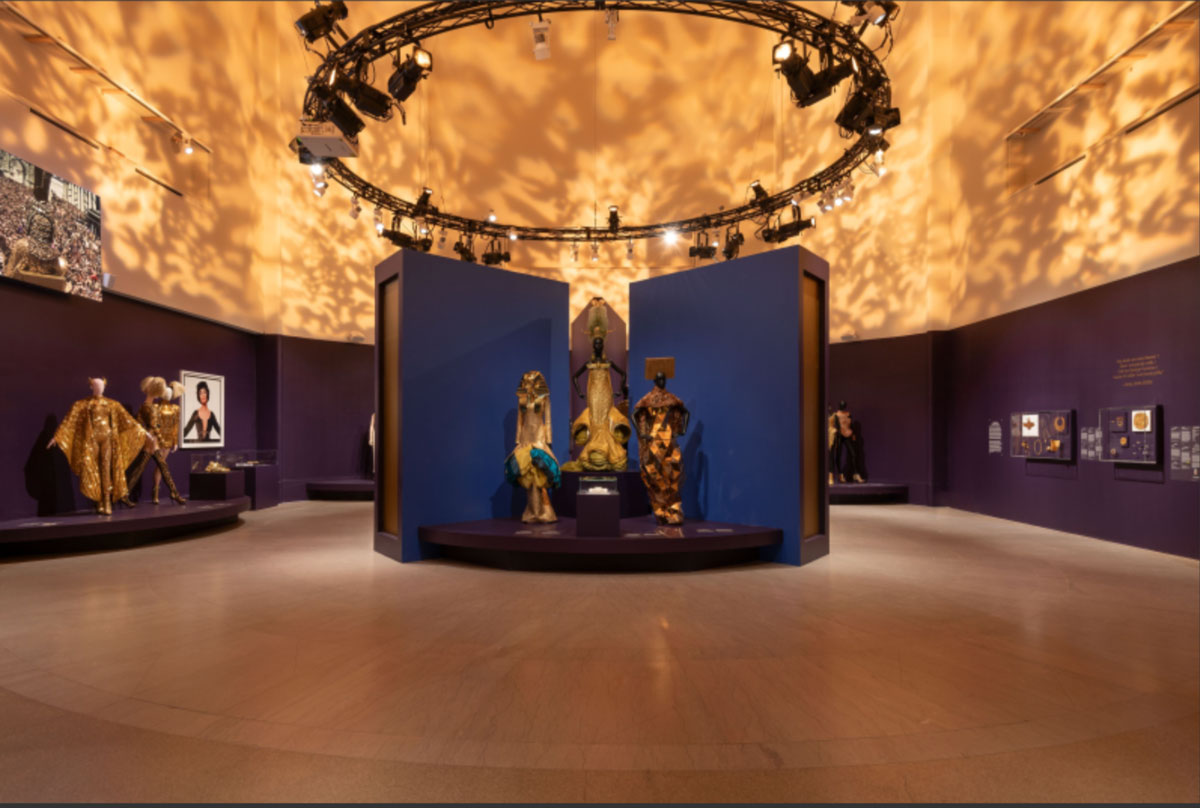NEWLY OPENED EXHIBITION

Rubin Museum Tibetan Buddhist Shrine Room. (Photo: Dave De Armas, courtesy of the Rubin Museum of Himalayan Art)
Rubin Museum Tibetan Buddhist Shrine Room
June 11, 2025 – April 20, 2031
Member Evenings: Thursday, June 26, 7-9pm
Arts of Asia Galleries, 2nd Floor
A lamplit sanctuary amid the bustle of Brooklyn—and a refuge in uncertain times—the Rubin Museum Tibetan Buddhist Shrine Room is a place to learn, reflect, and seek inspiration. The installation presents more than 100 artworks and ritual objects as they would be displayed in an elaborate household shrine, where devotees make offerings, pray, and meditate. Scroll paintings (thangkas), sculptures, furniture, and musical instruments dating from the 12th to 20th century are carefully arranged according to Tibetan Buddhist tradition. Chanted prayers by monks and nuns reflect the ritual practices and remind visitors that Buddhist rituals engage all the senses.
More than one million people experienced the Shrine Room when it was exhibited in its original location, the Rubin Museum of Himalayan Art in Manhattan, from 2013 to 2024. To ensure New York City residents and visitors can continue to enjoy this space, it has been given a new home at the Brooklyn Museum. The immersive installation will welcome guests within the Arts of Asia galleries for six years. A virtual exploration of the Shrine Room will allow visitors worldwide to enjoy this evocative sanctuary from home.
To learn more, click here.
ONGOING EXHIBITIONS
Breaking the Mold: Brooklyn Museum at 200
February 28, 2025 – February 22, 2026
Curator-led Member Tour: March 20, 2025, 6–7:30pm
Decorative Arts and Design Galleries, 4th Floor
From groundbreaking early acquisitions to striking new additions, the Brooklyn Museum’s collection has always championed artists and artworks that catalyze imaginative storytelling and brave conversations. As we ring in our 200th anniversary, Breaking the Mold: Brooklyn Museum at 200 celebrates this unique legacy. Comprising three chapters that boast both longtime favorites and brand-new standouts, the exhibition brings fresh narratives to the fore while exploring the collection’s rich history and future evolution.
Brooklyn Made is an homage to art and design created in the borough from the 17th century to today. Beginning with a pair of Delaware youth moccasins that acknowledge the land’s original inhabitants, this chapter journeys through time to spotlight works by active Brooklyn artists such as KAWS, Duke Riley, and Tourmaline. Building the Brooklyn Museum and Its Collection features transformational artworks and archival materials that trace the development of the collection as well as the Beaux-Arts building that houses it. Gifts of Art in Honor of the 200th showcases extraordinary contemporary works—paintings, photographs, video, sculpture, ceramics, and more—given to us by valued donors in honor of our bicentennial. Exemplary pieces by well-established artists such as Julie Mehretu, Robert Frank, Alex Katz, and Coco Fusco are joined by contributions from influential artists working today, many in Brooklyn. Telling the Museum’s story along with their own, these works reveal how the collection continues to reflect our changing world.
Breaking the Mold: Brooklyn Museum at 200 is organized by Meghan Bill, Coordinator of Provenance; Abigail Dansiger, Director of Libraries and Archives; Catherine Futter, Director of Curatorial Affairs and Senior Curator of Decorative Arts; Liz St. George, Assistant Curator of Decorative Arts; and Pauline Vermare, Phillip and Edith Leonian Curator of Photography; with Kimberli Gant, Curator, Modern and Contemporary Art; Carmen Hermo, former Associate Curator, Elizabeth A. Sackler Center for Feminist Art; Michael Gibson-Prugh, Curatorial Assistant, Arts of the Americas and Europe, and Imani Williford, Curatorial Assistant, Photography, Fashion, and Material Culture.
To learn more and view all the related events, click here.

Vishnu and Lakshmi with Vishnu’s Avatars, Northern India (Rajasthan), 10th century, sandstone, 43 1/2 x 22 1/2 x 7in., purchase gift of the Charles Bloom Foundation, Inc., 86.191.
Arts of Asia Collection
Arts of Asia and the Islamic World, 2nd Floor
We house one of America’s foremost collections of Asian art, now displayed in newly renovated galleries. We have completed a multiyear reinstallation that celebrates the great diversity of Asian art by presenting works from Japan, Korea, China, South and Southeast Asia, and the Himalayas, as well as the arts of Buddhism.
The Arts of Japan gallery features traditional forms such as paintings, woodblock prints, sculptures, and lacquerwares. We have a large, historical collection of art made by the Ainu people of northern Japan, which is prominent in the gallery, as is our important collection of ceramics by modern and contemporary masters.
Among the first U.S. institutions to collect and exhibit Korean art, we hold one of the country’s premier collections. The Arts of Korea gallery offers a full range of traditional ceramic wares as well as fine paintings, costumes, home furnishings, and religious arts.
The Arts of China gallery ranges from the Neolithic era (circa 3000 B.C.E.) to today. Objects in a wide variety of mediums reveal the sophistication of Chinese artistry and reflect Chinese religious, political, and intellectual traditions that continue to evolve.
The Arts of Buddhism gallery offers an introduction to Buddhism through its art forms, featuring art from multiple Asian cultures. Juxtaposed icons of Buddhas, Bodhisattvas, and other enlightened figures, as well as tools used in worship, illustrate regional variations in practice and aesthetics.
Arts of Southeast Asia highlights our collection of historical art from the region, with a primary focus on sculpture depicting Hindu and Buddhist deities.
The largest gallery in the suite, Arts of South Asia showcases our important holdings of art from India and surrounding regions, featuring stone sculptures from Hindu and Jain temples. Celebrating a diversity of forms and traditions, the installation includes highlights from our extensive collections of manuscript paintings and early terracotta sculptures as well as decorative objects and architectural elements.
The smallest gallery in the suite, Arts of the Himalayas features sculpture and paintings from Nepal, Tibet, and neighboring regions, most of it made for use in Buddhist or Hindu religious practices.
The Arts of Asia galleries are organized by Joan Cummins, Lisa and Bernard Selz Senior Curator, Asian Art, in collaboration with Susan Beningson (Arts of China) and Alison Baldassano (Arts of the Himalayas).
To learn more, click here.
RECENT PAST EXHIBITION

Installation view, Solid Gold, November 16, 2024–July 6, 2025. Photo by Paula Abreu Pita
Solid Gold
November 16, 2024 – July 6, 2025
Morris A. and Meyer Schapiro Wing and Iris and B. Gerald Cantor Gallery, 5th Floor
Behold the majesty of gold in a shimmering exhibition dedicated to the element that has inspired countless works of art, fashion, film, music, and design. As a material and a color, gold has symbolized beauty, honor, joy, ritual, spirituality, success, and wealth throughout history. It has also taken on myriad forms: from millennia-old depictions of an idealized world to opulent 13th- and 14th-century Italian altarpieces and intricate Japanese screens, to contemporary artwork and haute couture marvels. With a sweeping range of objects and a global perspective, this exhibition traces the many odysseys of the metal that has influenced cultures and legacies worldwide.
Opening on the occasion of the Brooklyn Museum’s 200th anniversary, Solid Gold features more than 400 works, pairing showpieces from the collection with stunning international loans, including standout fashion designs, paintings, sculptures, coins and jewelry.
While celebrating the seductive magic of this luminous material, the exhibition also confronts darker histories, inviting frank discussions about the human and environmental costs of extracting gold ore from the earth. Solid Gold will immerse you in one of humankind’s most dazzling obsessions.
To learn more, view an in-depth video, and see related events, click here.

